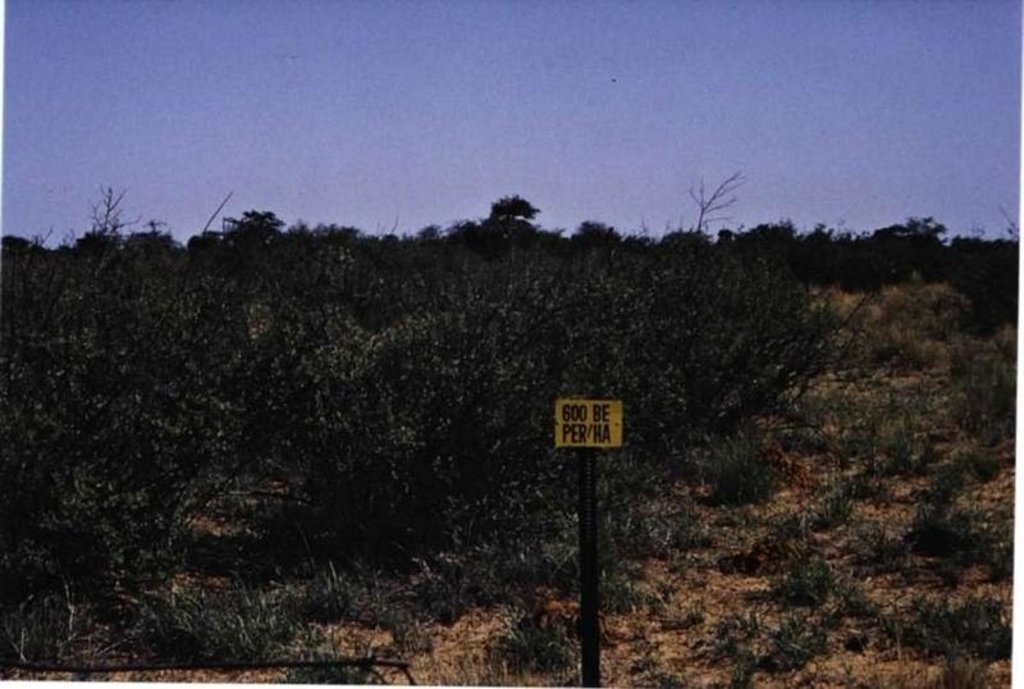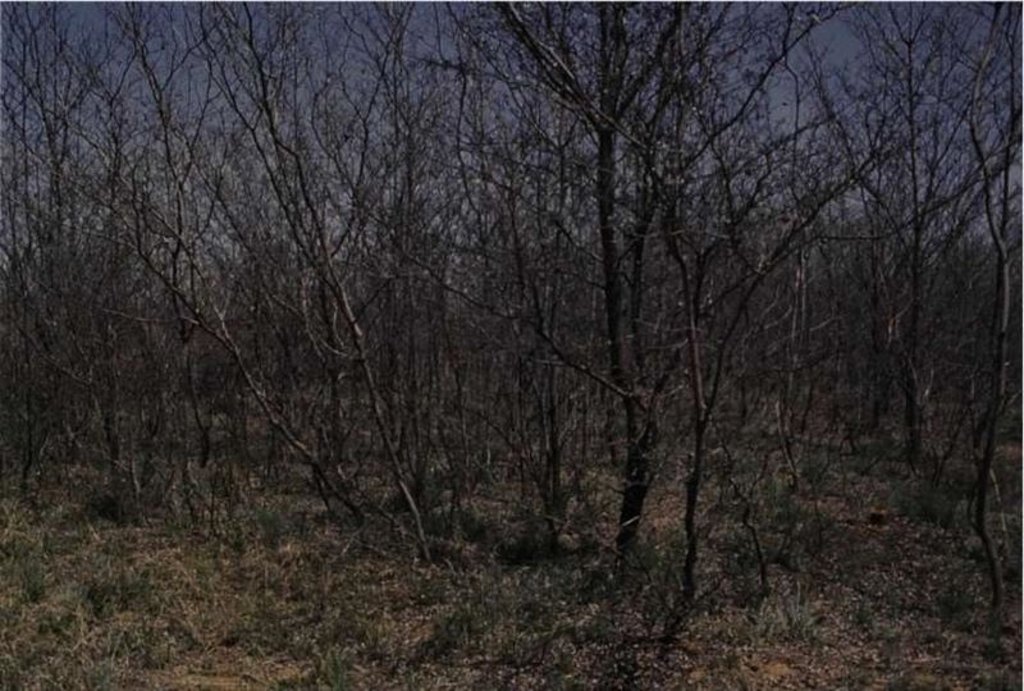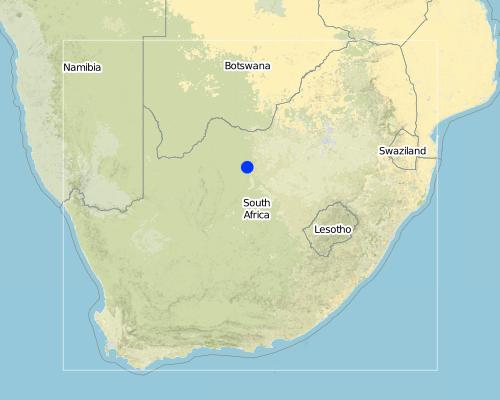Chemical bush control [South Africa]
- Creation:
- Update:
- Compiler: Unknown User
- Editor: –
- Reviewer: David Streiff
Chemical bush control with special reference to thinning and clearing
technologies_1375 - South Africa
View sections
Expand all Collapse all1. General information
1.2 Contact details of resource persons and institutions involved in the assessment and documentation of the Technology
Key resource person(s)
SLM specialist:
Richter Chris
Department of Agriculture, South Africa
South Africa
Name of the institution(s) which facilitated the documentation/ evaluation of the Technology (if relevant)
Department of Agriculture of Zambia (Department of Agriculture) - Zambia1.3 Conditions regarding the use of data documented through WOCAT
When were the data compiled (in the field)?
12/12/2003
The compiler and key resource person(s) accept the conditions regarding the use of data documented through WOCAT:
Yes
2. Description of the SLM Technology
2.1 Short description of the Technology
Definition of the Technology:
To either clear or thin bush (trees) in encroached areas by chemical means.
2.2 Detailed description of the Technology
Description:
In some areas, the bushes are so dense (more than 2000 plants/ha) that access to the area is not possible and therefore the aerial application of chemicals is the only solution. All the plants in this area get treated this way, but no selective treatment is possible (this is still a problem to overcome). This aerial application can be selective to some extent because some bushes survive the treatment. If that is the case, selected thinning with chemical bush control can be done on bushes (but not on palatable/usable species).
The purpose was to characterise and control bush encroachment; to define and quantify grass-bush interactions in mixed savannahs, by chemical bush control; to be able to make recommendations for larger application chemical bush control like by aerial application. There was a lack of a technique for economic comparison between the potential loss of income due to bush encroachment and the cost of controlling bush.
Aftercare is very important and is an on-going process. After the first application of the chemicals, it is possible to let in goats. Browsers are better than game, because they browse the small bushes and prevent the area from further bush encroachment. The application of fire is also possible. In this area it should only be done every 7th -10th year (depending on the rainfall and grass production). There is very little communal land in this large area (5 million ha).
2.3 Photos of the Technology
2.5 Country/ region/ locations where the Technology has been applied and which are covered by this assessment
Country:
South Africa
Region/ State/ Province:
North West Province & Northern Cape
Further specification of location:
Vryburg, Griekwastad, Mafekeng
Map
×2.6 Date of implementation
If precise year is not known, indicate approximate date:
- less than 10 years ago (recently)
2.7 Introduction of the Technology
Specify how the Technology was introduced:
- through projects/ external interventions
Comments (type of project, etc.):
Started as a research project by the Department of Agriculture in the middle - late sixties and have been updated since the eighties.
3. Classification of the SLM Technology
3.1 Main purpose(s) of the Technology
- Improve access to land
3.2 Current land use type(s) where the Technology is applied

Grazing land
Extensive grazing land:
- Ranching
Main animal species and products:
Cattle, sheep
Comments:
Major land use problems (compiler’s opinion): The negative impact that bush encroachment has on the production and botanical composition of the grass layer in these areas - thus making economical farming impossible.
Major land use problems (land users’ perception): The negative impact that bush encroachment has on the production and botanical composition of the grass layer in these areas - thus making economical farming impossible.
In the small communal areas camps are not used, the area is overstocked.
Ranching: Cattle, sheep
Grazingland comments: A definite shift to game farming and production. Grazing capacity is 10 ha/LSU. Economic farm unit perceived as to be not smaller than 3000 ha.
Type of grazing system comments: A definite shift to game farming and production. Grazing capacity is 10 ha/LSU. Economic farm unit perceived as to be not smaller than 3000 ha.
3.3 Further information about land use
Number of growing seasons per year:
- 1
Specify:
Longest growing period in days: 180; Longest growing period from month to month: Oct - Apr
3.4 SLM group to which the Technology belongs
- Tap/deploy land
3.5 Spread of the Technology
Specify the spread of the Technology:
- evenly spread over an area
If the Technology is evenly spread over an area, indicate approximate area covered:
- 100-1,000 km2
Comments:
Total area covered by the SLM Technology is 1.4 m2.
The developed technology, bush cleaning & control, will be applied on +- 5 million ha. * The technologies assist of thinning, cleaning & eradication
3.6 SLM measures comprising the Technology

vegetative measures
- V3: Clearing of vegetation
3.7 Main types of land degradation addressed by the Technology

soil erosion by water
- Wt: loss of topsoil/ surface erosion

water degradation
- Ha: aridification
Comments:
Secondary types of degradation addressed: Wt: loss of topsoil / surface erosion
Main causes of degradation: over-exploitation of vegetation for domestic use (Decrease in game led to over utilising of grass and under utilisation of woody species.), education, access to knowledge and support services (Lack of knowledge - Farmers didn't realise that they were causing the problem by not management correctly the veld)
Secondary causes of degradation: overgrazing (Especially new & around water), other natural causes (avalanches, volcanic eruptions, mud flows, highly susceptible natural resources, extreme topography, etc.) specify (Limiting of natural fires)
3.8 Prevention, reduction, or restoration of land degradation
Specify the goal of the Technology with regard to land degradation:
- reduce land degradation
- restore/ rehabilitate severely degraded land
Comments:
Secondary goals: mitigation / reduction of land degradation
4. Technical specifications, implementation activities, inputs, and costs
4.1 Technical drawing of the Technology
4.2 Technical specifications/ explanations of technical drawing
Technical knowledge required for field staff / advisors: moderate
Technical knowledge required for land users: moderate
Main technical functions: improvement of ground cover
Secondary technical functions: control of dispersed runoff: retain / trap, increase / maintain water stored in soil
4.3 General information regarding the calculation of inputs and costs
other/ national currency (specify):
Rand
Indicate exchange rate from USD to local currency (if relevant): 1 USD =:
6.0
Indicate average wage cost of hired labour per day:
7.00
4.4 Establishment activities
| Activity | Type of measure | Timing | |
|---|---|---|---|
| 1. | Soil applied chemicals (tebuthiuron) | Vegetative | Not important, better close to rainy season |
4.5 Costs and inputs needed for establishment
| Specify input | Unit | Quantity | Costs per Unit | Total costs per input | % of costs borne by land users | |
|---|---|---|---|---|---|---|
| Labour | Apply chemicals | ha | 1.0 | 40000.0 | 40000.0 | |
| Equipment | Tools | ha | 1.0 | 6000.0 | 6000.0 | |
| Construction material | chemicals, subsistence allowan | ha | 1.0 | 20000.0 | 20000.0 | |
| Total costs for establishment of the Technology | 66000.0 | |||||
Comments:
Duration of establishment phase: 12 month(s)
4.6 Maintenance/ recurrent activities
| Activity | Type of measure | Timing/ frequency | |
|---|---|---|---|
| 1. | Burning the veld | Management | / 7-10 years |
| 2. | Browsing the veld by goats | Management |
4.7 Costs and inputs needed for maintenance/ recurrent activities (per year)
| Specify input | Unit | Quantity | Costs per Unit | Total costs per input | % of costs borne by land users | |
|---|---|---|---|---|---|---|
| Labour | Burning and browsing the veld | ha | 1.0 | 10000.0 | 10000.0 | |
| Equipment | Tools | ha | 1.0 | 1500.0 | 1500.0 | |
| Fertilizers and biocides | Chemicals, subsistence allowan | ha | 1.0 | 5000.0 | 5000.0 | |
| Total costs for maintenance of the Technology | 16500.0 | |||||
Comments:
High salary of researcher and technician are included in the costs.
4.8 Most important factors affecting the costs
Describe the most determinate factors affecting the costs:
For all 4 plots. They were working on each plot for 3 months. Travel and subsistence costs.
5. Natural and human environment
5.1 Climate
Annual rainfall
- < 250 mm
- 251-500 mm
- 501-750 mm
- 751-1,000 mm
- 1,001-1,500 mm
- 1,501-2,000 mm
- 2,001-3,000 mm
- 3,001-4,000 mm
- > 4,000 mm
Specifications/ comments on rainfall:
The average is +-340mm
Agro-climatic zone
- semi-arid
5.2 Topography
Slopes on average:
- flat (0-2%)
- gentle (3-5%)
- moderate (6-10%)
- rolling (11-15%)
- hilly (16-30%)
- steep (31-60%)
- very steep (>60%)
Landforms:
- plateau/plains
- ridges
- mountain slopes
- hill slopes
- footslopes
- valley floors
Altitudinal zone:
- 0-100 m a.s.l.
- 101-500 m a.s.l.
- 501-1,000 m a.s.l.
- 1,001-1,500 m a.s.l.
- 1,501-2,000 m a.s.l.
- 2,001-2,500 m a.s.l.
- 2,501-3,000 m a.s.l.
- 3,001-4,000 m a.s.l.
- > 4,000 m a.s.l.
Comments and further specifications on topography:
Slopes on average: All sites in the North West Province are flat and only the one site in the Northern Cape is hilly
Altitudinal zone: Duncan, 1057m, Karlsruehe 1200-1500m, Slabbertshof 1130m
5.3 Soils
Soil depth on average:
- very shallow (0-20 cm)
- shallow (21-50 cm)
- moderately deep (51-80 cm)
- deep (81-120 cm)
- very deep (> 120 cm)
Soil texture (topsoil):
- coarse/ light (sandy)
- medium (loamy, silty)
Topsoil organic matter:
- low (<1%)
If available, attach full soil description or specify the available information, e.g. soil type, soil PH/ acidity, Cation Exchange Capacity, nitrogen, salinity etc.
Soil depth on average: The site in the Northern Cape is very shallow North West Province the soils are very deep
Soil texture: Coarse in the North West and medium in the Northern Cape
Soil fertility is medium- low in both areas concerned. Very sandy soils, however, and have a poor fertility
Soil drainage / infiltration is good in the North West and poor in the Northern Cape
Soil water storage capacity is low: Plexut 71 mm at a depth 2.1m
5.6 Characteristics of land users applying the Technology
Market orientation of production system:
- commercial/ market
Off-farm income:
- 10-50% of all income
Relative level of wealth:
- average
Indicate other relevant characteristics of the land users:
Population density: < 10 persons/km2
Annual population growth: 1% - 2%
15% of the land users are rich and own 20% of the land (Commercial).
85% of the land users are average wealthy and own 80% of the land (Compared with other commercial farmers).
Off-farm income specification: up to 25% farmers get involved in ecotourism (trend is to more game for ecotourism and hunting)
5.7 Average area of land owned or leased by land users applying the Technology
- < 0.5 ha
- 0.5-1 ha
- 1-2 ha
- 2-5 ha
- 5-15 ha
- 15-50 ha
- 50-100 ha
- 100-500 ha
- 500-1,000 ha
- 1,000-10,000 ha
- > 10,000 ha
5.8 Land ownership, land use rights, and water use rights
Land ownership:
- communal/ village
- individual, not titled
Land use rights:
- communal (organized)
- individual
6. Impacts and concluding statements
6.1 On-site impacts the Technology has shown
Socio-economic impacts
Production
fodder production
Comments/ specify:
Primary production grasses, all seasons, composition changes
fodder quality
animal production
Comments/ specify:
With regard to woody component (game farming)
product diversity
Comments/ specify:
Higher grazing capacity
land management
Comments/ specify:
Creating an open Savannah
Income and costs
farm income
Other socio-economic impacts
Initial cost
Ecological impacts
Soil
soil moisture
Comments/ specify:
Decrease in encroachers
soil cover
Comments/ specify:
Grass density, all seasons
Biodiversity: vegetation, animals
habitat diversity
Comments/ specify:
Change of habitat
6.4 Cost-benefit analysis
How do the benefits compare with the establishment costs (from land users’ perspective)?
Short-term returns:
negative
Long-term returns:
positive
How do the benefits compare with the maintenance/ recurrent costs (from land users' perspective)?
Short-term returns:
neutral/ balanced
Long-term returns:
slightly positive
6.5 Adoption of the Technology
- more than 50%
If available, quantify (no. of households and/ or area covered):
90 percent of the area
Of all those who have adopted the Technology, how many have did so spontaneously, i.e. without receiving any material incentives/ payments?
- 0-10%
Comments:
90% of land user families have adopted the Technology with external material support
There is a strong trend towards spontaneous adoption of the Technology
Comments on adoption trend: See it is working, improvement of the veld return on the inputs
6.7 Strengths/ advantages/ opportunities of the Technology
| Strengths/ advantages/ opportunities in the land user’s view |
|---|
| Improvement in grazing capacity |
| Improvement of veld condition and production |
| Accessibility |
| Strengths/ advantages/ opportunities in the compiler’s or other key resource person’s view |
|---|
| Improvement of veld condition and production |
| Accessibility (because it was to dense) |
6.8 Weaknesses/ disadvantages/ risks of the Technology and ways of overcoming them
| Weaknesses/ disadvantages/ risks in the land user’s view | How can they be overcome? |
|---|---|
| Very expensive |
| Weaknesses/ disadvantages/ risks in the compiler’s or other key resource person’s view | How can they be overcome? |
|---|---|
| Under aero-application utilisable plants can be irradiated, if not adhered to directive | Hand application |
| Very expensive |
7. References and links
7.2 References to available publications
Title, author, year, ISBN:
Msc of C. Richter, Gras-bosinteraksie in die bosveldgebiede van Noord-Kaap. 1991.
Available from where? Costs?
C. Richter
Links and modules
Expand all Collapse allLinks
No links
Modules
No modules









